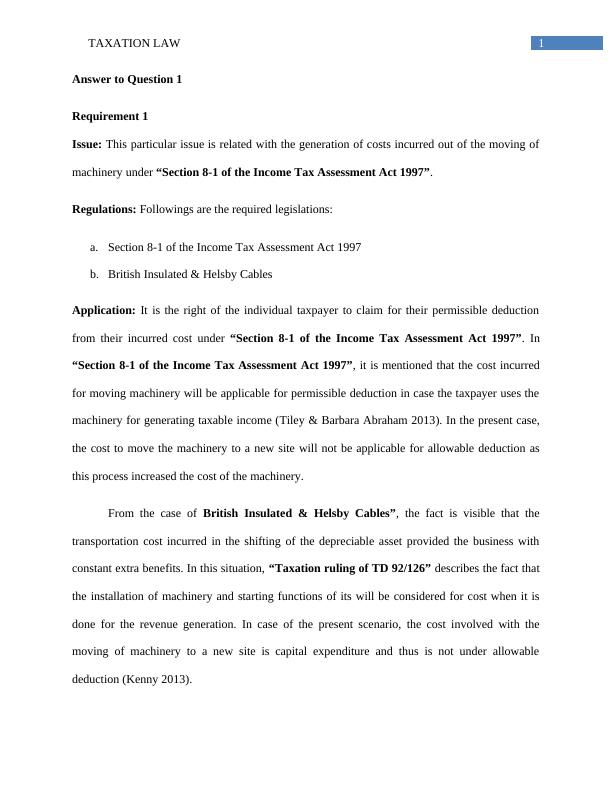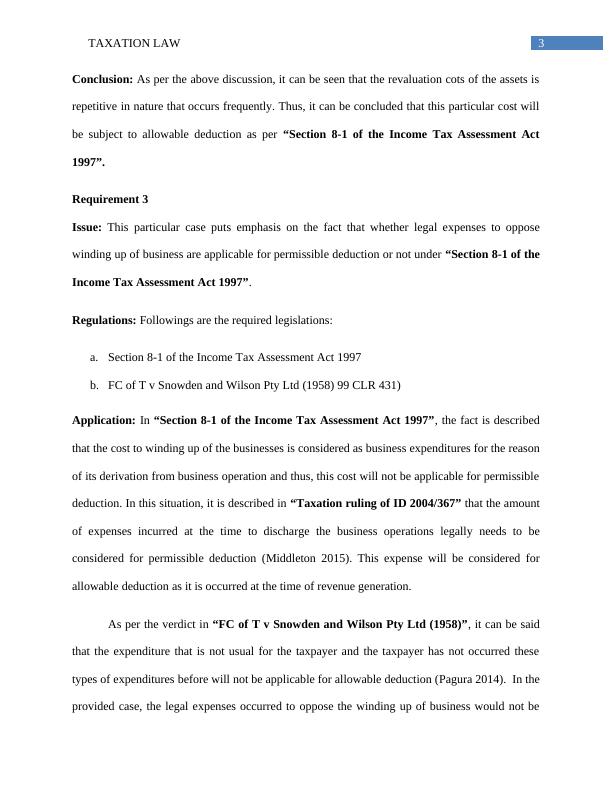Assignment Taxation Law | Income Tax Assessment Act
13 Pages2637 Words126 Views
Added on 2020-04-07
Assignment Taxation Law | Income Tax Assessment Act
Added on 2020-04-07
ShareRelated Documents
Running head: TAXATION LAWTaxation LawName of the StudentName of the UniversityAuthor’s Note

1TAXATION LAWAnswer to Question 1Requirement 1Issue: This particular issue is related with the generation of costs incurred out of the moving ofmachinery under “Section 8-1 of the Income Tax Assessment Act 1997”.Regulations: Followings are the required legislations:a.Section 8-1 of the Income Tax Assessment Act 1997b.British Insulated & Helsby CablesApplication: It is the right of the individual taxpayer to claim for their permissible deductionfrom their incurred cost under “Section 8-1 of the Income Tax Assessment Act 1997”. In“Section 8-1 of the Income Tax Assessment Act 1997”, it is mentioned that the cost incurredfor moving machinery will be applicable for permissible deduction in case the taxpayer uses themachinery for generating taxable income (Tiley & Barbara Abraham 2013). In the present case,the cost to move the machinery to a new site will not be applicable for allowable deduction asthis process increased the cost of the machinery.From the case of British Insulated & Helsby Cables”, the fact is visible that thetransportation cost incurred in the shifting of the depreciable asset provided the business withconstant extra benefits. In this situation, “Taxation ruling of TD 92/126” describes the fact thatthe installation of machinery and starting functions of its will be considered for cost when it isdone for the revenue generation. In case of the present scenario, the cost involved with themoving of machinery to a new site is capital expenditure and thus is not under allowablededuction (Kenny 2013).

2TAXATION LAWConclusion: Thus, based on the above discussion, it can be concluded that as per “Section 8-1of the Income Tax Assessment Act 1997”, the cost to move the machinery will not be subjectto allowable deduction as it is a capital expenditure.Requirement 2Issue: The issue is related with the revaluation of assets that affects the insurance cover. It needsto be determined that whether the cost to revaluation is applicable for allowable deduction as per“Section 8-1 of the Income Tax Assessment Act 1997”.Regulations: The relevant regulation is “Section 8-1 of the Income Tax Assessment Act1997”.Application: From the provided information about the case, it can be seen that the cost isgenerated out of the revaluation of the assets and this cost affects the insurance cover. It needs tobe mentioned that this cost of revelation of assets will be applicable for allowable deduction asthis particular cost of occurred repetitively under “Section 8-1 of the Income Tax AssessmentAct 1997” (Martin 2015). Apart from this fact, it needs to be mentioned that the assetrevaluation cost that can affect the insurance cover has direct relation with the fixed assets. It isrequired for the taxpayer at the time to compute the tax return to determine the deductible natureof the expenditure. More precisely, it needs to be ascertained that whether the revaluation cost ofthe assets occurred due to the generation of taxable income of it is occurred in order to safeguardthe assets. In case of this particular situation, the revaluation cost of the machinery contributed tothe temporary benefit of the company and this particular cost is repetitive in nature. For thisreason, this revaluation cost of assets will be applicable for permissible deduction under“Section 8-1 of the Income Tax Assessment Act 1997” (Bevacqua 2015).

3TAXATION LAWConclusion: As per the above discussion, it can be seen that the revaluation cots of the assets isrepetitive in nature that occurs frequently. Thus, it can be concluded that this particular cost willbe subject to allowable deduction as per “Section 8-1 of the Income Tax Assessment Act1997”.Requirement 3Issue: This particular case puts emphasis on the fact that whether legal expenses to opposewinding up of business are applicable for permissible deduction or not under “Section 8-1 of theIncome Tax Assessment Act 1997”.Regulations: Followings are the required legislations:a.Section 8-1 of the Income Tax Assessment Act 1997b.FC of T v Snowden and Wilson Pty Ltd(1958) 99 CLR 431)Application: In “Section 8-1 of the Income Tax Assessment Act 1997”, the fact is describedthat the cost to winding up of the businesses is considered as business expenditures for the reasonof its derivation from business operation and thus, this cost will not be applicable for permissiblededuction. In this situation, it is described in “Taxation ruling of ID 2004/367” that the amountof expenses incurred at the time to discharge the business operations legally needs to beconsidered for permissible deduction (Middleton 2015). This expense will be considered forallowable deduction as it is occurred at the time of revenue generation.As per the verdict in “FC of T v Snowden and Wilson Pty Ltd (1958)”, it can be saidthat the expenditure that is not usual for the taxpayer and the taxpayer has not occurred thesetypes of expenditures before will not be applicable for allowable deduction (Pagura 2014). In theprovided case, the legal expenses occurred to oppose the winding up of business would not be

End of preview
Want to access all the pages? Upload your documents or become a member.
Related Documents
Taxation Law Name of the Student Name of the University Authorslg...
|15
|1752
|46
Taxation Law Answer to Question Assignmentlg...
|14
|2328
|276
HI3042 - Taxation Law Assignmentlg...
|11
|1611
|181
Taxation Law Name of the Student Name of the Universitylg...
|12
|1786
|370
Assignment on Income Tax Assessment Actlg...
|15
|2018
|32
Law Assignment | Utilization of Taxation Lawlg...
|15
|1793
|186
